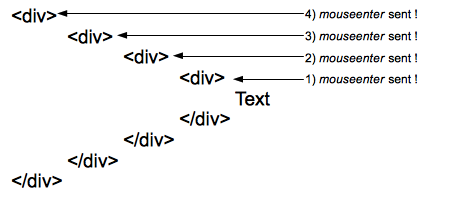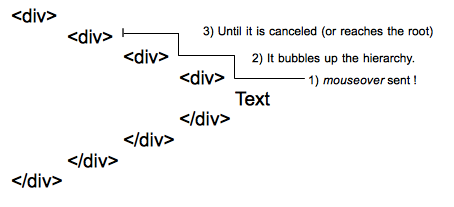The mouseenter event is fired at an Element when a pointing device (usually a mouse) is initially moved so that its hotspot is within the element at which the event was fired.
| Bubbles | No |
|---|---|
| Cancelable | No |
| Interface | MouseEvent |
| Event handler property | onmouseenter |
Usage notes
Though similar to mouseover, mouseenter differs in that it doesn't bubble and it isn't sent to any descendants when the pointer is moved from one of its descendants' physical space to its own physical space.

mouseenter event is sent to each element of the hierarchy when entering them. Here 4 events are sent to the four elements of the hierarchy when the pointer reaches the text.

mouseover event is sent to the deepest element of the DOM tree, then it bubbles up the hierarchy until it is canceled by a handler or reaches the root.With deep hierarchies, the number of mouseenter events sent can be quite huge and cause significant performance problems. In such cases, it is better to listen for mouseover events.
Combined with the corresponding mouseleave (which is fired at the element when the mouse exits its content area), the mouseenter event acts in a very similar way to the CSS :hover pseudo-class.
Examples
The mouseover documentation has an example illustrating the difference between mouseover and mouseenter.
mouseenter
The following trivial example uses the mouseenter event to change the border on the div when the mouse enters the space alloted to it. It then adds an item to the list with the number of the mouseenter or mouseleave event.
HTML
<div id='mouseTarget'> <ul id="unorderedList"> <li>No events yet!</li> </ul> </div>
CSS
Styling the div to make it more visible.
#mouseTarget {
box-sizing: border-box;
width:15rem;
border:1px solid #333;
}
JavaScript
var enterEventCount = 0;
var leaveEventCount = 0;
const mouseTarget = document.getElementById('mouseTarget');
const unorderedList = document.getElementById('unorderedList');
mouseTarget.addEventListener('mouseenter', e => {
mouseTarget.style.border = '5px dotted orange';
enterEventCount++;
addListItem('This is mouseenter event ' + enterEventCount + '.');
});
mouseTarget.addEventListener('mouseleave', e => {
mouseTarget.style.border = '1px solid #333';
leaveEventCount++;
addListItem('This is mouseleave event ' + leaveEventCount + '.');
});
function addListItem(text) {
// Create a new text node using the supplied text
var newTextNode = document.createTextNode(text);
// Create a new li element
var newListItem = document.createElement("li");
// Add the text node to the li element
newListItem.appendChild(newTextNode);
// Add the newly created list item to list
unorderedList.appendChild(newListItem);
}
Result
Specifications
| Specification | Status |
|---|---|
| UI Events The definition of 'mouseenter' in that specification. |
Working Draft |
| Document Object Model (DOM) Level 3 Events Specification The definition of 'mouseenter' in that specification. |
Obsolete |
Browser compatibility
| Desktop | Mobile | |||||||||||
|---|---|---|---|---|---|---|---|---|---|---|---|---|
mouseenter event | Chrome Full support 30 | Edge Full support 12 | Firefox Full support 10 | IE Full support 5.5 | Opera Full support 17 | Safari Full support 6.1 | WebView Android Full support ≤37 | Chrome Android Full support 30 | Firefox Android Full support 10 | Opera Android Full support 18 | Safari iOS Full support 6.1 | Samsung Internet Android Full support 2.0 |
Legend
- Full support
- Full support
